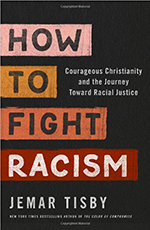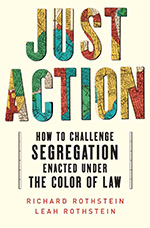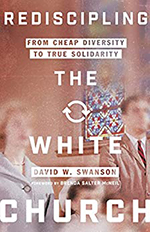
by Katie Boland
 Jemar Tisby says, "Fighting racism does not consist of a set of isolated actions that you take; rather these actions must flow from an entire disposition that is oriented toward racial justice. We have to reposition ourselves spiritually, emotionally, culturally, intellectually, and politically to address the myriad ways that racism manifests itself in the present day. Racial justice is a lifestyle not an agenda item." or to put it another way, "Fighting racism is not just about how it changes the world; it's also about how it changes you." I have certainly found this to be true in my own life.
Jemar Tisby says, "Fighting racism does not consist of a set of isolated actions that you take; rather these actions must flow from an entire disposition that is oriented toward racial justice. We have to reposition ourselves spiritually, emotionally, culturally, intellectually, and politically to address the myriad ways that racism manifests itself in the present day. Racial justice is a lifestyle not an agenda item." or to put it another way, "Fighting racism is not just about how it changes the world; it's also about how it changes you." I have certainly found this to be true in my own life.
by David Brooks
Reviewed by: Vicki Foreman
In a culture where we seem to be divided by ideological labels wouldn't it be healing to toss labels and connect with others with respect, consideration, and curiosity? David Brooks' book, How to Know a Person, offers a guide to being "open-hearted" and learning to deeply know another person and to be deeply seen. Currently, as a society, our social skills are inadequate to the task. Brooks argues that we can learn the skills to connect with others, to learn from their perspectives, to make others feel valued and understood, and in turn find something of larger value in ourselves.
Our stories matter in understanding each other. Our families, our culture, our personalities, our sorrows and joys are far more complex than neat labels. Learning to ask open-ended questions, listening to understand, and looking for the richness and depth of another person are essential in breaking down misunderstanding and broadening our own perspectives and potential for joyful relationships.
Brooks draws on science, research, philosophy, history, and education to help the reader craft their own approach and ability to have meaningful conversations and relationships. He encourages an attitude of welcome to counter hostility and misperception.
My takeaway from this book is to talk less and listen more, to be curious about others' stories and to pay attention to the possibilities for questions that lead to new appreciation and understanding of another human. I'm currently a work in progress. My takeaway is hopeful for dropping labels, seeing others more deeply, and getting better at skills that will cause others to feel valued, understood, and loved. As Brooks relates in an anecdote about a pastor, "he is trying to see that person the way Jesus would see that person. He is trying to see them with Jesus's eyes - eyes that lavish love on the meek and the lowly, the marginalized and those in pain, and on every living person."
Reviewed by Pam Hinrichs
 Just Action is a follow-up to The Color of Law, written by Richard Rothstein. The Color of Law has been called a landmark work. It described and documented how Federal, State, and local governments purposefully implemented comprehensive racist housing policies and segregation well into the latter part of the 20th century and the consequences of those policies and laws that continue into the present. It is not necessary to read The Color of Law before Just Action because Just Action contains an excellent concise summary of The Color of Law.
Just Action is a follow-up to The Color of Law, written by Richard Rothstein. The Color of Law has been called a landmark work. It described and documented how Federal, State, and local governments purposefully implemented comprehensive racist housing policies and segregation well into the latter part of the 20th century and the consequences of those policies and laws that continue into the present. It is not necessary to read The Color of Law before Just Action because Just Action contains an excellent concise summary of The Color of Law.
Reviewed by Anthony Ballard
 Any Christian who has spent time engaging in racial justice work has been told to "just preach the Gospel."
Any Christian who has spent time engaging in racial justice work has been told to "just preach the Gospel."
When a friend of mine told me to "just preach the Gospel" it panged me because I knew that preaching the Gospel was the most important message of the Christian faith. I believed racial justice was a key part of the Gospel, however, all I really knew about the Gospel was that it leads to personal salvation. I felt stuck. So, I began to ask the question, what is the Gospel and how does it have something to say about the movement for racial justice?
This led me to a rereading of the Gospels and seeking supporting resources about the Kingdom of God.
Reviewed by Grace Brown
 For an entire page in this book the author repeats over and over: "Can we love one another's children?"
For an entire page in this book the author repeats over and over: "Can we love one another's children?"
The answer to this question is what the author is trying to answer in writing about her own experiences as a white mom sending her white kids to their locally zoned diverse Oakland neighborhood public school. This book, written in stories and streams of consciousness, is just a book of experiences. Through it, the author grapples (struggles) with her privilege, her choices, her decisions, her whys and hows. As the reader, we witness the author's love grow and expand for her neighborhood, her children's school, and ultimately, one another's children.
by Nancy Gibson
Summary
"Patrick Reyes shares his story of how the community around him…saved him from gang life, abuse and the economic and racial oppression that threatened to kill him before he ever reached adulthood. Nobody Cries When We Die takes you to the places that make American society flinch, redefines what you are called to do with your life, and gives you strength to save lives and lead in your own community." [Summary from Amazon.com]
Meaningful Quote
"We Latinx are conditioned by the violence of a colonial world that has rendered us a people without a history, without an identity, without significance."
Key Takeaway
This book helped me to better understand the lived experience of many people in our society. I realize that I need to do better at listening to people's stories and experiences, rather than just trying to help (or judge) based on my own perceptions.
Reviewed by Heather Hedlund
In Reading While Black, Esau McCaulley writes that the way the Black church has practiced reading and interpreting the Bible has been a crucial source of hope in the midst of unjust circumstances. He calls this practice Black ecclesial interpretation.
McCaulley explains the foundational elements of Black ecclesial interpretation and provides several examples of how to apply these elements to specific issues that challenge the Black community such as political witness, policing, pursuing justice, and slavery. This is not a dry theological text; McCaulley is an engaging writer and includes many stories from his own experiences as he helps us understand Scripture more deeply.
By Grace Brown
 The response of white Christians to address racial blind spots and assumptions often defaults in white communities and churches to try to become more racially diverse to solve the problems. Swanson asserts that the segregation within white Christianity is not actually a diversity problem, but really a discipleship problem. American culture disciples white Christianity toward racial segregation and injustice. Swanson encourages white Christians to honestly assess the damage done by misguided forms of discipleship. He then outlines a rethinking of discipleship practices, including new habits, teaching, and uncommon friendship, that can lead us into authentic solidarity as members of the diverse body of Christ. The reader finishes the book having reckoned with painful truths, bringing forth hope and a reorientation to the diverse kingdom of God.
The response of white Christians to address racial blind spots and assumptions often defaults in white communities and churches to try to become more racially diverse to solve the problems. Swanson asserts that the segregation within white Christianity is not actually a diversity problem, but really a discipleship problem. American culture disciples white Christianity toward racial segregation and injustice. Swanson encourages white Christians to honestly assess the damage done by misguided forms of discipleship. He then outlines a rethinking of discipleship practices, including new habits, teaching, and uncommon friendship, that can lead us into authentic solidarity as members of the diverse body of Christ. The reader finishes the book having reckoned with painful truths, bringing forth hope and a reorientation to the diverse kingdom of God.
Page 2 of 4